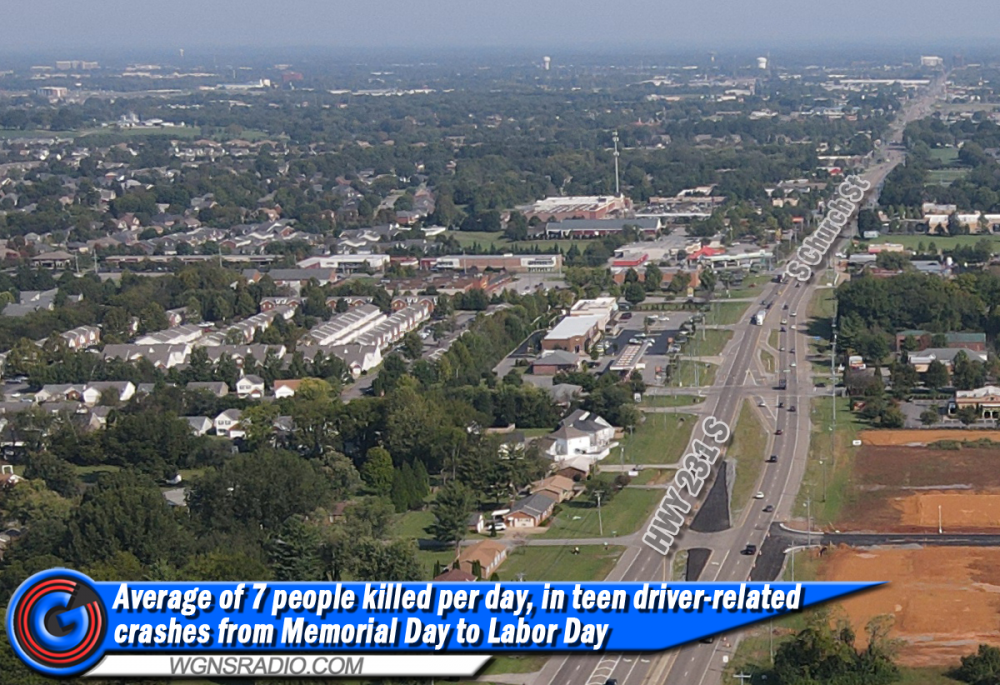Memorial Day weekend marked the unofficial start of summer and a dangerous time of year for young drivers. Nationwide, more than 30 percent of deaths involving teen drivers occur during what’s called the “100 Deadliest Days” - a period that runs from Memorial Day to Labor Day.
For every mile driven, new teen drivers (ages 16-17 years old) are three times more likely to be involved in a deadly crash compared to adults. Now that school is out for summer, these inexperienced teen drivers will have more time to spend on the road. That means more time driving at night and potentially engaging in risky behaviors like speeding, texting, or simply sharing the vehicle with teen passengers. The risk gets even greater when you add more vehicles on the road.
“This summer could prove to be even more dangerous for teen drivers as the 100 Deadliest Days coincides with what is expected to be a busier summer driving season than last year,” said Megan Cooper, spokeswoman for AAA – The Auto Club Group. “AAA expects two years’ worth of pent up travel demand to be unleashed in the coming months. That means more traffic on our roadways, which raises the crash risk – particularly for young, inexperienced drivers.”
100 Deadliest Days statistics from 2011 - 2020
Nationwide
- Each year an average of 2,063 teen drivers are involved in fatal crashes; 642 of those (31%) occurred during the 100 deadliest days
- More than 7,124 people died in teen-related summertime crashes from 2011 to 2020.
- That’s more than seven people a day each summer compared to the rest of the year (six people/day).
Tennessee
- An average of 18 teen drivers are involved in fatal crashes during this time.
- On average, 70 people are killed in teen driver-related crashes every year; 19 (27%) of those occur during the 100 deadliest days.
- 190 people were killed in teen driver-related crashes during the past 10 summers.
Risky Habits for Teen Drivers
“Teens’ inexperience behind the wheel makes them more susceptible to dangerous driving behaviors – like speeding, distracted driving, and driving while drowsy,” continued Cooper. “Even young drivers that are prepared and focused carry an increased crash risk due to their lack of experience behind the wheel. That’s why it’s so important for parents to play an active role in guiding their teens toward safe driving behaviors.”
Understanding the risks and knowing the facts will prepare both you and your teen for the road ahead:
- Driving with teen passengers. Teen drivers’ crash risks multiply when they have teen passengers. Set limits and enforce them.
- Driving at night. Night driving is more dangerous due to limited visibility, fatigue, and impaired drivers on the road. This is especially a risky time for teens. Limit the time your novice driver spends behind the wheel at night.
- Not wearing a safety belt. Wearing a safety belt greatly reduces the risk of being hurt or killed in a crash. Make a rule: everyone buckles up for every trip.
- Speeding. Speed is a leading factor in crashes for teens and adults. Teens need to follow posted speed limits and parents should set a good example and strong rules. Teens should also learn how to adjust their speed based on roadway factors like reduced traction and visibility and varying traffic volumes.
- Distracted driving. Teen passengers are the biggest distraction to teen drivers, but cell phones come in second. Many teens admit to interacting with their phone and in-car infotainment systems while behind the wheel despite clear dangers. Make a family rule covering these and other distractions that everyone abides by.
- Drowsy driving. Teens have a hard time getting enough sleep and often struggle with drowsiness. Drowsy driving is as dangerous as drunk driving, and teens have the highest risk. Ensure everyone who is behind the wheel has gotten enough sleep.
- Impaired driving. Driving impaired from alcohol and other drugs puts everyone at risk. Enforce strict zero tolerance rules with your teen and be a good role model.
AAA Advice for Parents
The single most important thing parents can do to keep their teens safe behind the wheel is to be actively involved in the learning to drive process:
- Talk with teens early and often about abstaining from dangerous behavior behind the wheel, such as speeding, impairment and distracted driving.
- Teach by example- Maintain appropriate space around your vehicle, adjust your speed to the conditions and minimize risky behavior when you drive.
- Establish a parent-teen driving agreement that sets family rules for teen drivers.
- Conduct at least 50 hours of supervised practice driving with their teen.
- Enroll your teen in both online and in-person driving courses.
- Talk with your teens about anticipating other driver’s mistakes and how to adjust their driving to others.
AAA’s How to Drive Program for Teens
Quality driver education is critical in developing safe driving behaviors for teens. That’s why AAA, a leader in driver safety for over 75 years, developed an online, supplemental program for teen drivers.
AAA’s How to Drive Online provides a solid foundation of the knowledge and skills necessary to reduce a teen’s risk behind the wheel. This program is an online, 25 hour course that features:
- Convenient, self-paced delivery
- Research-based curriculum
- Videos, simulations, and interactive exercises to enhance content retention
- Optional virtual parent session to help educate parents on the learning to drive process
Behind-the-Wheel Training
The AAA Approved Driving School Network is designed to help identify the best driver training resources in your local community. These schools have passed AAA’s stringent standards and offer quality curriculum as well as the best value for students.
Visit here to find our AAA Approved Driving schools in your area. To learn more, contact DriverTraining2@acg.aaa.com or call (888) 222-7108.
About AAA - The Auto Club Group
The Auto Club Group (ACG) is the second largest AAA club in North America with more than 13 million members across 14 U.S. states, the province of Quebec and two U.S. territories. ACG and its affiliates provide members with roadside assistance, insurance products, banking and financial services, travel offerings and more. ACG belongs to the national AAA federation with more than 62 million members in the United States and Canada. AAA’s mission is to protect and advance freedom of mobility and improve traffic safety. For more information, get the AAA Mobile app, visit AAA.com, and follow us on Facebook, Twitter and LinkedIn.






